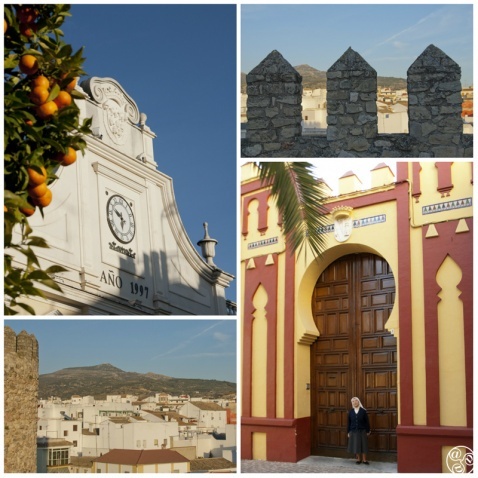
Cabra town hall laden with oranges, the fortress and the Palacio de los Condes de Cabra. © Michelle Chaplow |
|
THINGS TO SEE IN CABRA
Castillo
The castle was first built by the Arabs and later conquered and enlarged by the Christians. The Counts of Cabra converted the castle into their permanent residence from the sixteenth century, and in the seventeenth century it became the Convent of Capuchin Franciscans. Today, the largest portion of the castle is used by the local school. The castle is located on Plaza del Conde de Cabra.
Parroquia de la Asunción y Ángeles
This church is of medieval origin and was built by the Brothers of Calatrava on the site of a former mosque. It was dedicated to Santa Maria de los Angeles in 1241, the date of the conquest of the city by Fernando III. The eighteenth-century altarpiece is the work of Melchor de Aguirre and the building still retains its 44 dramatic red marble columns. The building can be found on Calle Mayor.
Iglesia de San Juan de Dios
Although this church was founded in the sixteenth century (1568), the current structure is from the seventeenth. It was annexed onto the Convent of the Brothers of the Order until 1835. Located on Calle José de Silva.
Parroquia de los Remedios
This church was built on the remains of the sixteenth-century chapel of Santa Ana. The image of the Virgen de la Soledad, the work of Pedro de Mena, was acquired in Granada in 1663. The presbytery is covered with a beautiful plasterwork dome designed by Antonio Álvarez, who also designed the main altarpiece. This was gilded in 1744 by Francisco Ponce de León, ten years after its construction. The church can be found on Plaza de Aguilar y Eslava.
Parroquia de Santo Domingo de Guzmán
This building was the first Convent of Cabra, founded in 1550 from a small hermitage, and is located on Calle San Juan de Dios.
Casa de Cayetano Muriel
This is the house where the singer Cayetano Muriel was born, who is better known artistically as "Niño de Cabra". He is considered the first famous flamenco singer, who performed throughout Spain and was the first to record on slate records. Adored and respected by fans for his creativity and mastery of multiple styles, he is considered to be the best singer of the fandangos of Lucena. The house is located on Calle Cuesta de San Juan.
Espada del Cid Campeador
Hanging to a column is the Tizona, the sword of Mio Cid, that acknowledges his great victory in the "Battle of Cabra". It was this defeat that apparently gave him the name of campeador (battler). The monument can be seen on Calle Mayor.
Plaza de Toros
The bullring is the oldest in the province of Córdoba, inaugurated on June 24, 1857 by Francisco Arjona Guillén "Cuchares" and Antonio Sánchez "Tato". It underwent renovations in 1888 and in 1904. The arena measures 43m and has capacity for 6,167 spectators. Located on Avenida de la Constitución.
Museo Arqueológico Municipal
The Archaeological Museum was established by Ministerial Order on January 15, 1973, with its headquarters in the Town Hall. In 1984, it moved to the Casa de Cultura. The exhibition occupies most of the ground floor "Patio de Columnas", so named for its ten red marble columns that form a square covered enclosure. The cultural centre housing these exhibits is located on Calle Martín Belda.
Opening Times:
Tuesday-Saturday, 09:30-14:00hrs and 17:00-20:00hrs
Sunday, 09:30-14:00hrs
Tel: 957 52 01 10
Museo de Historia Natural (Aguilar y Eslava)
The Natural History Museum has garnered great prestige, and for several years the Aguilar y Eslava Foundation has worked to make one of its most ambitious projects a reality, the creation of the Aguilar y Eslava Museum, where the rich pedagogical, historical, artistic and sentimental heritage of the area's 300-year history is preserved and exhibited. The museum is on Plaza Aguilar y Eslava.
Opening Times:
Friday, 18:00-20:00hrs
Saturday, 11:00-14:00hrs and 18:00-20:00hrs
Price: Free Entrance
Tel: 957 59 69 30
Museo del Aceite "El Molino Viejo"
The building which houses the oil museum is a clear example of local nineteenth-century industrial architecture. The exhibition offers a guide to the different methods and gadgets invented to extract the liquid gold that is olive oil. The museum is located on Vado del Moro.
Opening Times:
Monday-Saturday, 09:00-14:00hrs
Precio: 1,50 euro
Tel: 957 52 17 71, 957 52 49 24